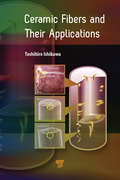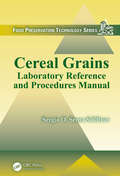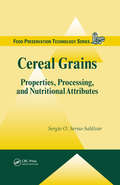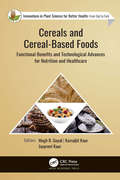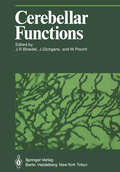- Table View
- List View
Ceramic Fibers and Their Applications
by Toshihiro IshikawaTo date, several polymer-derived ceramic fibers have been developed all over the world, out of which SiC fibers synthesized from polycarbosilane and their derivatives have achieved highest heat resistance and show excellent mechanical properties. Their use in ceramic matrix composite materials has resulted in high-temperature stability and light weight, which show great promise in next-generation applications, such as aerospace engines. This book presents polymer-derived ceramic fibers from a historical viewpoint; basic information about them, such as production process, fine structures, and physical properties; their applications; and prospects of future inorganic fibers.
Cereal Genomics
by R. K. Varshney Pushpendra K. GuptaCereals make an important component of daily diet of a major section of human population, so that their survival mainly depends on the cereal grain production, which should match the burgeoning human population. Due to painstaking efforts of plant breeders and geneticists, at the global level, cereal production in the past witnessed a steady growth. However, the cereal production in the past has been achieved through the use of high yielding varieties, which have a heavy demand of inputs in the form of chemical fertilizers, herbicides and insecticides/pesticides, leading to environmental degradation. In view of this, while increasing cereal production, one also needs to keep in mind that agronomic practices used for realizing high productivity do not adversely affect the environment. Improvement in cereal production in the past was also achieved through the use of alien genetic variation available in the wild relatives of these cereals, so that conservation and sustainable use of genetic resources is another important area, which is currently receiving the attention of plant breeders. The work leading to increased cereal production in the past received strong support from basic research on understanding the cereal genomes, which need to be manipulated to yield more from low inputs without any adverse effects as above. Through these basic studies, it also became fairly apparent that the genomes of all cereals are related and were derived from the same lineage, million of years ago.
Cereal Grains: Laboratory Reference and Procedures Manual (Food Preservation Technology Ser.)
by Sergio O. Serna-SaldivarEmphasizing the essential principles underlying the preparation of cereal-based products and demonstrating the roles of ingredients, Cereal Grains: Laboratory Reference and Procedures Manual is a practical laboratory manual complementing the author's text, Cereal Grains: Properties, Processing, and Nutritional Attributes. Organized so that readers
Cereal Grains: Laboratory Reference and Procedures Manual (Food Preservation Technology Ser.)
by Sergio O. Serna-SaldivarEmphasizing the essential principles underlying the preparation of cereal-based products and demonstrating the roles of ingredients, Cereal Grains: Laboratory Reference and Procedures Manual is a practical laboratory manual complementing the author's text, Cereal Grains: Properties, Processing, and Nutritional Attributes. Organized so that readers
Cereal Grains: Properties, Processing, and Nutritional Attributes (Food Preservation Technology Ser.)
by Sergio O. Serna-SaldivarWhile cereals remain the world's largest food yield - with more than 2.3 billion metric tons produced annually - consumer demands are on the rise for healthier cereal products with greater nutrition. Cereal Grains: Properties, Processing, and Nutritional Attributes provides a complete exploration of the scientific principles related to domesticatio
Cereal Grains: Properties, Processing, and Nutritional Attributes
by Sergio O. Serna-SaldivarWhile cereals remain the world's largest food yield - with more than 2.3 billion metric tons produced annually - consumer demands are on the rise for healthier cereal products with greater nutrition. Cereal Grains: Properties, Processing, and Nutritional Attributes provides a complete exploration of the scientific principles related to domesticatio
Cereals and Cereal-Based Foods: Functional Benefits and Technological Advances for Nutrition and Healthcare
by Megh R. Goyal Kamaljit Kaur Jaspreet KaurThis book volume sheds light on the health benefits of selected cereal grains, processing technologies of cereals, specific roles of bioactive compounds of cereals in chronic disease prevention, and traditional and latest technologies to improve the functional benefits of cereal-based products. It presents a thorough review of the functional components of some lesser known or forgotten cereals and their role in maintaining good health. With advancements in cereal science and technology, new methods of processing have emerged that help to preserve or even enhance the health-benefitting properties of cereal grains. Further, plant breeding and biotechnology have contributed greatly in improving nutritional quality and functionality of these grains. This book provides comprehensive information on the simple as well as advanced methodologies for enhancing the properties of cereals that benefit human health. Some new approaches such as bio-fortification and extraction of bioactives from cereals are also included in the text.
Cereals and Nutraceuticals
by Jyoti Singh Joginder Singh Sawinder Kaur Prasad RasaneThis book is focused on the production, cultivation, processing, composition, nutritional value, value addition, health implications, limitations and safety of nutricereals with an emphasis on their functional significance. With changing food habits and increasing health concerns, consumers around the world are opting for a more nutritious diet than that was consumed until recently. Nutricereals are now becoming a food of choice for many and newer products are being developed using them. Thus, a better understanding of these valuable crops is becoming essential. Researchers and scientists around the world have now turned their attention to nutricereals as a cheaper and most important solution to nutritional deficiencies. Processing of these cereals is matter of advanced research in recent times to make it suitable and palatable for human consumption and taste, and hence high emphasis is given on processing and value addition of these cereals. A comprehensive account of these important aspects is highly required. The book covers specific aspects of the nutricereals of consumption pattern and acceptance and the cultivation practices and health benefits associated with their consumption. Considerations on processing, value addition and safety associated with various nutricereals and current and future challenges and the opportunities for its utilization are highlighted in the book. This book forms an important resource on nutricereals for food technologists and food scientists.
Cerebellar Cortex: Cytology and Organization
by S.L. Palay V. Chan-PalayThe origins of this book go back to the first electron microscopic studies of the central nervous system. The cerebellar cortex was from the first an object of close study in the electron microscope, repeating in modern cytology and neuroanatomy the role it had in the hands of RAMON y CAJAL at the end of the nineteenth century. The senior author vividly remembers a day early in 1953 when GEORGE PALADE, with whom he was then working, showed him an electron micrograph of a cerebellar glomerulus, saying "That is what the synapse should look like. " It is true that the tissue was swollen and the mitochondria were exploded, but all of the essentials of synaptic structure were visible. At that time small fragments of tissue, fixed by immersion in osmium tetroxide and embedded in methacrylate, were laboriously sectioned with glass knives without any predetermined orientation and then examined in the electron microscope. After much searching, favorably preserved areas' were studied at the cytological level in order to recognize the parts of neurons and characterize them. Such procedures, dependent upon random sections and uncontrollable selection by a highly erratic technique of preservation, precluded any systematic investigation of the organization of a particular nucleus or region of the central nervous system. It was difficult enough to distinguish neurons from the neuroglia.
Cerebellar Degenerations: Clinical Neurobiology (Foundations of Neurology #2)
by Andreas PlaitakisThis book encompasses basic and clinical reports on the cerebellum and its primary atrophic disorders, the cerebellar degenerations. Rapid progress has been made in undestanding the organization and function of the cerebellum at the neuronal, synaptic, and molecular level. Of particular importance has been the identification of the chemical transmitters utilized by the cer ebellar cellular systems. More than any other brain region, the cerebellum utilizes amino acids as its main excitatory and inhibitory neurotransmitters. Excitatory amino acid transmitters, in addition to serving neuronal com munication, may also mediate trophic and toxic effects, and as such, they may playa role in neurodegenerative processes. The cerebellar degenerations were among the first human disorders with primary system atrophy to be studied clinically and pathologically. This field of clinical cerebellar sciences, no longer confined to the previously known descriptive level, is now advancing rapidly, propelled by rapid advances in neuroimaging, immunology, and molecular biology. The advent of CT, MRI, and PET has in recent years permitted the study of central nervous system alterations in living patients, thus contributing substantially to the accuracy of the diagnosis and the classification of these disorders. The nosology of cerebellar degenerations, which has been the subject of much debate for over a century, is presently a dynamic field, with new entities being recognized and old "classic ataxias" being redefined in the light of new genetic evidence.
Cerebellar Dentate Nucleus: Organization, Cytology and Transmitters
by V. Chan-PalayRecent physiologic investigations have shown that the deep cerebellar nuclei may play an important role in the initiation and monitoring of skilled move ments. Much of this physiologic work has been carried out in the absence of a secure foundation in neuroanatomical information. Although the main sources of the afferent fibers and the major terminations of the efferent fibers related to these nuclei have been known for many years, remarkably little information about the organization of the nuclei themselves has been collected. The kinds of nerve cells, their arrangement within the nuclei, the patterns of their dendritic arborizations, the distribution of incoming fibers among the neurons, the relationship between the outgoing nerve fibers and the nerve cells from which they originate - these and many other morphologic features were either unknown or only superficially explored. In fact, so little was known about the deep cerebellar nuclei when I began to work on this subject that the investigations reported here are virtually without antecedents, a refreshing change from the cerebellar cortex which has been repeatedly and exhaustively surveyed. My studies on the cerebellar nuclei began in the spring of 1972. They were initiated with the intent of applying the principles of analysis that had been developed for the cerebellar cortex to a different but related part of the brain.
Cerebellar Functions (Proceedings in Life Sciences)
by J. Bloedel J. Dichgans W. PrechtOver the past few semesters a group of neurologists, neurophysiologists, and brain theorists in various departments of Tlibingen University have gathered periodically in an effort to review ideas and evidence on cerebel lar functions. At times, general solutions seemed close, when credit was given to various theoretical proposals advanced since the early days of cer ebellar physiology, however, it became clear in every case that a large part of the available facts refused to submit to the general ideas. As believers in the power of scientific discussion, we felt that the time was ripe for posing the problem of the cerebellum once more to a well articulated group of specialists that would include proponents of every disparate point of view. The sponsorship of the Max Planck Society and of the Deutsche Forschungsgemeinschaft, to whom we express our profound gratitude, made it possible to organize an international meeting in Septem ber, 1983. The aim of making new, even extravagant ideas palatable to each other was well accomplished by the participants. We trust that some of the ensuing excitement has been carried over into the printed version.
Cerebellar Infarct. Midline Tumors. Minimally Invasive Endoscopic Neurosurgery (Advances in Neurosurgery #22)
by Bernhard L. Bauer, Mario Brock and Margareta KlingerThe Cerebellum: Learning Movement, Language, and Social Skills
by Dianne M. BroussardThe Cerebellum provides a concise, accessible overview of modern data on physiology and function of the cerebellum as it relates to learning, plasticity, and neurodegenerative diseases. Encompassing anatomy and physiology, theoretical work, cellular mechanisms, clinical research, and disorders, the book covers learning and plasticity while introducing the anatomy of the cerebellum. Known and proposed "functions of the cerebellum" are addressed on clinical, physiological, cellular, and computational levels, providing academics, researchers, medical students, and graduate students with an invaluable reference.
The Cerebellum: Learning Movement, Language, and Social Skills
by Dianne M. BroussardThe Cerebellum provides a concise, accessible overview of modern data on physiology and function of the cerebellum as it relates to learning, plasticity, and neurodegenerative diseases. Encompassing anatomy and physiology, theoretical work, cellular mechanisms, clinical research, and disorders, the book covers learning and plasticity while introducing the anatomy of the cerebellum. Known and proposed "functions of the cerebellum" are addressed on clinical, physiological, cellular, and computational levels, providing academics, researchers, medical students, and graduate students with an invaluable reference.
The Cerebellum: Handbook of Clinical Neurology Series (ISSN #Volume 155)
by Mario Manto Thierry A.G.M. HuismanThe Cerebellum: Disorders and Treatment, Volume 155 updates readers on the latest and clinically relevant advances in the study of cerebellar diseases in children and adults. It is organized into sections detailing: (1) Disorders (starting from the fetal cerebellum, to adult cerebellum) encountered during daily practice, and (2) Therapy (including insights into innovative drug and rehabilitative approaches). The book's innovative structure discusses cerebellar disorders in children and adults as a continuum, with its companion volume, The Cerebellum: From Embryology to Diagnostic Investigations detailing embryology, anatomy, function and diagnostic investigations and neuroimaging, including conventional sequences, diffusion tensor imaging, functional MRI, and connectivity studies. Provides an in-depth understanding of the cerebellum and its involvement in a wide variety of diseasesExplores long-term outcome data of pediatric cerebellar diseases and potential problems in adult life for patients with pediatric cerebellar diseasesFeatures chapters co-authored by two experts, combining expertise in both pediatric and adult cerebellar diseases
The Cerebellum: Handbook of Clinical Neurology Series (ISSN #Volume 154)
by Mario Manto Thierry A.G.M. HuismanThe Cerebellum: From Embryology to Diagnostic Investigations, Volume 154 is designed to update the reader on the latest and clinically relevant advances in the study of cerebellar diseases in children and adults. It is organized into sections detailing: (1) Embryology, Anatomy and Function, and (2) Diagnostic investigations: Neuroimaging, and includes content on conventional sequences, diffusion tensor imaging, functional MRI, and connectivity studies. Its companion volume, The Cerebellum: Disorders and Treatment, describes disorders (starting from the fetal cerebellum, to adult cerebellum) encountered during daily practice and therapy (including insights into innovative drug and rehabilitative approaches to treat children and adults with cerebellar disorders). Provides an in-depth understanding of the cerebellum and its involvement in a wide variety of diseasesExplores the long-term outcome data of pediatric cerebellar diseases and potential problems in adult life for patients with pediatric cerebellar diseasesFeatures chapters co-authored by two experts, combining expertise in both pediatric and adult cerebellar diseases
Cerebellum and Neuronal Plasticity: (pdf) (Nato Science Series A: #148)
by M. Glickstein Christopher Yeo John SteinCerebellum as a CNS Hub (Contemporary Clinical Neuroscience)
by Hidehiro Mizusawa Shinji KakeiBased on the 75th Fujihara Seminar held in December 2018 in Tokyo, Japan, this volume explores the latest research on the cerebellum. Contributors seek to examine the cerebellum's role as a unique hub for brain activity and discover new information about its purpose. The discussion is broad, ranging from evolutionary topics to therapeutic strategy and addresses both physiology and pathology. Subjects covered include anatomy, information processing, complex spikes, plasticity, modeling, and spinocerebellar ataxias. The volume is intended to set the stage for the future of cerebellar research and guide both basic and clinical researchers.
The Cerebellum as a Neuronal Machine
by John C. EcclesThis book has had a three-fold origin, corresponding to the discoveries made by the three authors and their collaborators during the last few years - mostly since 1962. A most fruitful symposium on the cerebellum was held in Tokyo at the time of the International Physiological Congress in September 1965, and there was then formulated the project of writing this book so as to organize all this new knowledge and make it readily available, and to give opportunity for the con ceptual developments that may be seen in Chapters XI, XII and XV in particular. The present account of the physiological properties of the cerebellar cortex is based to a large extent on systematic investigations that were concerned with discovering the mode of operation of the constituent neuronal elements of the cerebellar cortex. This work was carried out in the Physiology Department of the Australian National University from 1963 to 1966 in collaboration with several visiting scientists - initially Drs. ANDERSEN, OscARssaN and VooRHOEVE and later Drs. LuNAs, SAsAKI and STRATA - to all of whom grateful thanks are extended for a great many of the figures, and even more significantly for the original and critical contributions that they made to so many aspects of this exploration into the mode of operation of the neural machinery of the cerebellar cortex.
The Cerebellum, Epilepsy, and Behavior
by Irving CooperIn cats anesthetized lightly with pentobarbital or alpha-chloralose, electrical stimulation of the paramedian lobule of cerebellum resulted in a change of EEG pattern. Prior to stimulation the pattern consisted of h igh-ampl itude slow waves with superimposed low-ampl itude fast activity. In addition, the EEGs of animals anesthetized with chloralose showed "chloralose spikes". Immediately following brief cerebellar stimulation the slow wave activity and spikes disappeared, leaving only low-voltage fast activity. The effect was most pronounced in the contralateral leads from the rostral portions of the cerebrum. Study of the parameters most effective in evoking this effect revealed that stimulation frequency, train duration, and probably pulse duration affected the duration of suppression in a sigmoid fashion, with inflection points at approximately 90 Hz, 2.5 sec, and 1 msec, respectively. Above threshold values, stimulation cur rent showed an approximately linear relationship to duration of EEG sup pression. The after-discharge resulting from focal electrical stimulation of the cerebral cortex could be shortened by electrical stimulation of the para median lobule. The effect was essentially the same when cerebellar stim ulation preceded, occurred during, or followed the cerebral cortical stim ulation. The great variability of the after-discharge resulting from cerebral cortical stimulation as well as the variability of the effects of cerebellar stimulation made it impractical to study systematically the parameters op timal for shorten ing after-discharge. Such a study wi II require use of an awake, preferably partially restrained animal with electrodes chronically implanted.
The Cerebellum Revisited
by Rodolfo Llinas Constantino SoteloThis book is organized into three parts that correspond with the main groups of chapters delivered during the Cajal Centenary Meeting on The Neutron Doctrine. These chapters represent important aspects of the morphology, development, and function of the cerebellum and related structures. Clearly an exhaustive analysis of all aspects of the cerebellar system, as they relate to the legacy of Ramon y Cajal, would be impossible to contain in just one volume, given its far-reaching impact. Instead, we deliberately steered away from the traditional handbook approach that some of us have taken in the past and selected those aspects of cerebellar research currently under vigorous study that would also represent the widest scope of interest for neuroscientists in general and for cerebellar specialists in particular. In particular, we felt that as the discrete anatomy of the cerebellum is quite well known, only certain aspects of the structure should be discussed here. For example, the organization of the pontocerebellar pathways, we felt, would be particularly interesting given the enormity of the system in higher vertebrates. Also of interest is the distribution and development of the synaptology and neurotransmitter properties in this cortex. Indeed, from the point of view of cerebellar development, this may represent one of the clearest paradigms in the understanding of rules for neurogenesis for the central nervous system.
Cerebral Amyloid Angiopathy in Alzheimer’s Disease and Related Disorders
by Marcel M. Verbeek Robert M. W. de Waal Harry V. VintersCerebral amyloid angiopathy (CAA) is a distinctive abnormality of small cerebral blood vessels, one that has intrigued neuroscientists for decades. The time seems right for a book which examines the phenomenon of CAA using a multifaceted approach: What does it produce clinically? How might CAA be imaged? What are the crucial biochemical/cellular events within cerebral vessel walls that lead to CAA? How can in vitro or transgenic experimental systems be used to understand the etiology of, or even potential treatments for, CAA? The editors have assembled key figures in the field of CAA research to examine these (and other) questions in a series of focused chapters that address specific issues of importance in understanding CAA and its clinical manifestations. Comprehending the biology and pathogenesis of this fascinating vascular lesion may even provide clues to less common forms of cerebral microvascular disease that have been recognized for decades (hypertensive microangiopathy) or more recently (CADASIL).
Cerebral Aneurysms: Advances in Diagnosis and Therapy
by H. W. Pia C. Langmaid J. ZierskiMicrosurgery has brought about important changes and progress in the treatment of cere bral aneurysms in recent years. Only 12 years ago McKissock, one of the most experienced surgeons in the treatment of aneurysms pompared the results of operative and nonoperative treatment. He found that mortality and morbidity of cerebral aneurysms was not significantly affected by whether the patients have been operated upon or not. This view is held by many neursurgeons, and was confirmed by results of the Co-operative Study in 1969. In the review on treatment of aneurysms in Progress in Neurological Surgery in 1969, techniques such as encasement with plastic compounds, piloinjection, stereotactic copper or electric thrombosis and metallic thrombosis and profound hypothermia in anaesthesia were listed. In general, these techniques now seem to be of little more than historical interest. Progress in recent yeats has been so enormous that one may perhaps gain the impreSSion that the main problems in the treatment of aneurysms have been solved and that there are no more to be surmounted. This is dangerous and complacent thinking, such as Lord Moynihan indulged in during the thirties. For this reason we thought that the time had come to assemble a group of experts who could discuss the various unsolved and contro versial problems of aneurysm surgery in the friendly and relaxed atmosphere of a "work shop".
Cerebral Aneurysms: Microvascular and Endovascular Management
by Robert R. Smith Yuri N. Zubkov Yahgoub TarassoliSurgical repair of cerebral aneurysms is a core aspect of neurosurgical practice. While open microvascular technique has dominated Western surgical practice, surgeons in the former USSR have developed endovascular techniques that have gained acceptance among surgeons here. This text demonstrates both surgical and endovascular approaches, written and illustrated by surgeons with vast experience in both, in a comparative context. The work is extensively illustrated with full-color surgical illustrations, line drawings, and radiographs.
